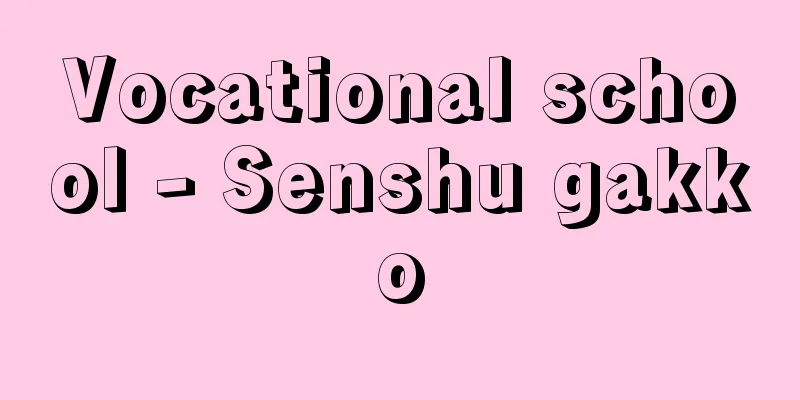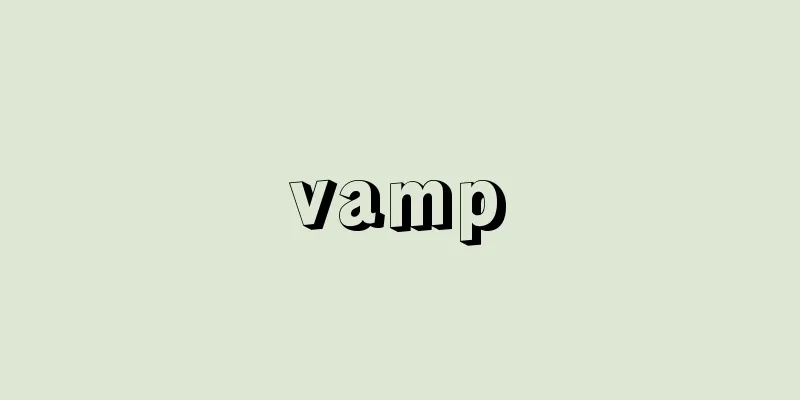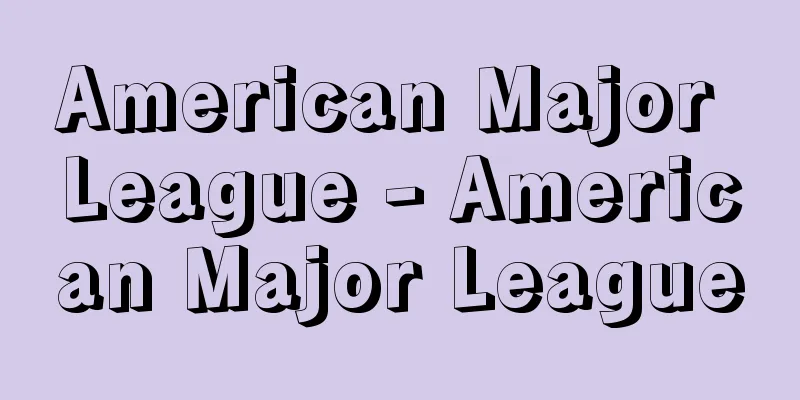Vocational school - Senshu gakko

|
In July 1975, the School Education Act was revised, and specialized training colleges were newly established in 1976 as organized educational institutions that met the requirements set out in the "Standards for Establishing Specialized Training Colleges" in Chapter 7, Section 2, and Article 82, Sections 2-10 of the Act (corresponding to Chapter 11, Articles 124-133 in the School Education Act as of 2009). Among the existing miscellaneous schools, those that provided organized education of a certain scale and standard were positioned as specialized training colleges, and the aim was to organize, improve, and promote them. [Toshiaki Kuwahara and Yoshinori Hirose] HistoryThe origins of technical colleges, including their predecessors in the school system, date back to the time of the enactment of the Education Act in 1879 (Meiji 12). Since then, miscellaneous schools have existed as various types of schools other than regular schools as defined by law, and after World War II, with the enactment of the School Education Act in 1947 (Showa 22), miscellaneous provisions in Article 83 stipulated them as educational institutions "similar to school education." This led to the establishment of the technical college system as described above. At the time of its establishment in 1976 (Showa 51), of the approximately 8,000 miscellaneous schools in the nation, approximately 1,000 had received approval to become specialized training schools, and the following year, in 1977, this number rose to approximately 2,000. After that, the number of schools and students both continued to increase, but peaked in 1992 (Heisei 4) and then began to decline, with the number of schools standing at 3,551 and the number of students at approximately 750,000 as of 2000. [Toshiaki Kuwahara and Yoshinori Hirose] Installation StandardsTechnical colleges are educational institutions that foster practical vocational skills and abilities necessary for real life, or improve general education, and are divided into higher, specialized, and general courses depending on the qualifications for admission. Courses after graduating from junior high school are called higher courses, courses after graduating from high school are called specialized courses, and all others are called general courses. Higher courses can be called higher technical colleges, and specialized courses can be called vocational schools. As of 2000, the ratio of students by course was 9.1% for higher courses, 84.9% for specialized courses, and 5.9% for general courses. Unlike the so-called "schools" defined in Article 1 of the School Education Law, the establishment standards are loosely stipulated, which gives them a positive organizational aspect in that they can flexibly respond to changes in educational needs due to changes in the times and society. The establishment standards include (1) minimum standards, such as a minimum period of study of one year or more, a minimum of 800 hours of class time per year (450 hours or more for nighttime classes), and a minimum of 40 students at all times. Other items include (2) admission qualifications, (3) principal qualifications, (4) teacher qualifications, (5) number of teachers, (6) departments, (7) school buildings, (8) school grounds, and (9) subject outlines, with the broad framework for each being stipulated by law. [Toshiaki Kuwahara and Yoshinori Hirose] Current situation and issuesVocational schools play a major role in the diversification of upper secondary and higher education, and in a lifelong learning society, and flexible institutional measures have been taken for this purpose. For example, since 1985, graduates of three-year higher vocational schools have been given the qualification to take university entrance exams, and the enhancement of vocational school education with a view to connecting with higher education institutions has become a further challenge. In addition, the 1994 revision of the establishment standards introduced a credit conversion system that takes into account the reality of day and night courses, subject-specific credit systems, and double schooling, and the title of specialist is now given to those who complete vocational schools. An important future challenge for vocational schools is to take advantage of their flexible organizational characteristics to creatively develop management and operation and educational content in response to rapid technological innovation and structural changes in industrial society. [Toshiaki Kuwahara and Yoshinori Hirose] Ministry of Education, Culture, Sports, Science and Technology, Promotion Division, Management Bureau, Legislation Research Group, ed., Commentary on the Specialized Training College System (1976, Gyosei) ▽ Sekiguchi Yoshi, Higher Education Series 7: The Complete Discussion of Specialized Training Colleges / 1975-2000: Ideas and Developments in the Period of Maturity and Selection (1990, Regional Science Research Association, Higher Education Information Center) ▽ Thirty-first Anniversary Project Special Committee Commemorative Publication Team, ed., The History of Specialized Training Colleges and Miscellaneous Schools (1992, Tokyo Association of Specialized Training Colleges and Miscellaneous Schools) ▽ Han Min, Modern Japan's Technical Schools: The Significance and Challenges of Higher Vocational Education (1996, Tamagawa University Press) [Reference] | |Source: Shogakukan Encyclopedia Nipponica About Encyclopedia Nipponica Information | Legend |
|
1975年(昭和50)7月、学校教育法が改正され、専修学校は、同法第7章の2、第82条の2~10の各条文(2009年現在の学校教育法においては第11章124~133条にあたる)で「専修学校設置基準」に規定される要件を満たす組織的教育機関として、1976年より新たに発足した。従来の各種学校のうち、一定の規模、水準を有する組織的な教育を行うものを専修学校として位置づけ、その整備・改善、振興を図ろうとしたのである。 [桑原敏明・広瀬義徳] 沿革専修学校の起源は、学校制度上その前身である各種学校を含めると、1879年(明治12)「教育令」制定の時期にまでさかのぼる。以後、各種学校は、法律に定める正規の学校以外の各種の学校として存在し、第二次世界大戦後は、1947年(昭和22)の学校教育法制定により、その第83条雑則で「学校教育に類する」教育機関として規定された。そして、上記のように専修学校制度の創設に至ったのである。 1976年(昭和51)の創設当時は、全国約8000校の各種学校のうち約1000校が、設置認可を受けて専修学校になり、翌1977年には約2000校になった。以後、学校数、生徒数ともに増加の一途をたどったが、1992年(平成4)をピークに、その後は減少傾向に転じ、2000年現在、学校数3551校、生徒数約75万人となっている。 [桑原敏明・広瀬義徳] 設置基準専修学校は、実践的な職業技術や実際生活に必要な能力を育成し、または一般教養の向上を図るための教育機関で、その入学資格によって高等課程、専門課程または一般課程が置かれている。中学校卒業後の課程を高等課程、高等学校卒業後の課程を専門課程、それ以外を一般課程とし、高等課程は高等専修学校、専門課程は専門学校と称することができる。ちなみに、2000年(平成12)現在の課程別生徒数の比率は、高等課程9.1%、専門課程84.9%、一般課程5.9%となっている。 いわゆる学校教育法第1条の「学校」とは異なり、設置基準も緩やかな規定となっているため、時代や社会の変化による教育ニーズの変容にも柔軟に対応できるという点に組織としての積極的な側面がある。設置基準には、(1)最低基準として、まず、修業年限1年以上、年間授業時数800時間以上(夜間の場合は450時間以上)、生徒数が常時40人以上などの規定がある。その他、(2)入学資格、(3)校長の資格、(4)教員の資格、(5)教員数、(6)学科、(7)校舎、(8)校地、(9)教科の大綱、といった項目があり、それぞれ大枠が法令上定められている。 [桑原敏明・広瀬義徳] 現状と課題後期中等教育および高等教育の多様化、あるいは生涯学習社会のなかで専修学校が果たす役割は大きく、そのための弾力的な制度的措置も講じられている。たとえば、1985年(昭和60)からは三年制高等専修学校卒業者には大学受験資格が付与されるなど、高等教育機関との接続を視野に入れての専修学校教育の充実がさらなる課題となっている。また、1994年の設置基準改正により、昼夜開講制や科目等履修制度、ダブルスクールなどの実態をも考慮した単位数換算方式などが導入されたり、専門学校修了者に専門士の称号が付与されたりするようになった。専修学校は、その柔軟な組織特性を生かして、急激な技術革新や産業社会の構造変化に応じた管理・経営と教育内容を創造的に展開していくことが、今後の重要な課題である。 [桑原敏明・広瀬義徳] 『文部省管理局振興課法令研究会編著『専修学校制度の解説』(1976・ぎょうせい)』▽『関口義著『高等教育シリーズ7 専修学校全論/1975―2000 成熟、選別期の発想と展開』(1990・地域科学研究会・高等教育情報センター)』▽『三十周年記念事業特別委員会記念誌チーム編『専修学校・各種学校の歩み』(1992・東京都専修学校各種学校協会)』▽『韓民著『現代日本の専門学校――高等職業教育の意義と課題』(1996・玉川大学出版部)』 [参照項目] | |出典 小学館 日本大百科全書(ニッポニカ)日本大百科全書(ニッポニカ)について 情報 | 凡例 |
Recommend
Cherry orchid
A perennial vine of the Asclepiadaceae family, nat...
Indirect assimilation policy
...a policy by a dominant group to assimilate oth...
Fujiwara no Maro
A politician of the Nara period. He was the fourt...
Good Knowledge - Zenchishiki
(Also called "zenjishiki") 1. A Buddhist...
Cripps Mission
In March 1942, as the situation in World War II wo...
Lycopod
Ferns are a group of polyphyletic vascular plants...
Yoshimi Hundred Caves
<br /> A group of cave tombs from the late K...
Merula, T.
…In response to these two functions, two types of...
Ugan - Ugan
...Sacred places similar to the mainland's sh...
Cloud Guest - Unkaku
〘Noun〙 (also "ungaku") 1. A person in th...
Rome - Rome (English spelling) loam
It is a word with two aspects in terms of meaning...
Electrophiles - Electrophiles
A chemical species that receives or shares electro...
Standard clock - hyojundokei
A highly accurate clock that serves as the standar...
Acta Senatus - Acta Senatus
...Today, many newspaper companies apply this spe...
martial arts film
...Kung fu is a Cantonese dialect word for a mart...









